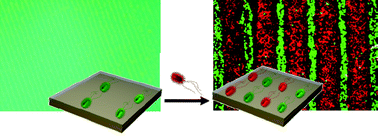The ability to spatially pattern bacterial co-cultures brings us closer to design a cellular environment emulating the bacterial heterogeneity in natural systems. Current bacterial patterning methods, however, can only pattern single bacterial cell types. Here, additive and subtractive microcontact printing (µCP), which was used in combination with surface chemistry to control bacterial adhesion, are compared and contrasted as to their ability to produce bacterial co-cultures. Using mannoside-terminated self-assembled monolayers as the adhesive surface, we demonstrate that the kinetics of bacterial adhesion is a key determinant of pattern integrity and robustness. Based on such considerations, we have established a straightforward approach based on subtractive µCP to produce spatially controlled and robust bacterial co-cultures that are viable and resist detachment due to shear, which we believe can be extensively adopted for important cell–cell communication studies such as horizontal gene transfer and quorum sensing.

You have access to this article
 Please wait while we load your content...
Something went wrong. Try again?
Please wait while we load your content...
Something went wrong. Try again?


 Please wait while we load your content...
Please wait while we load your content...